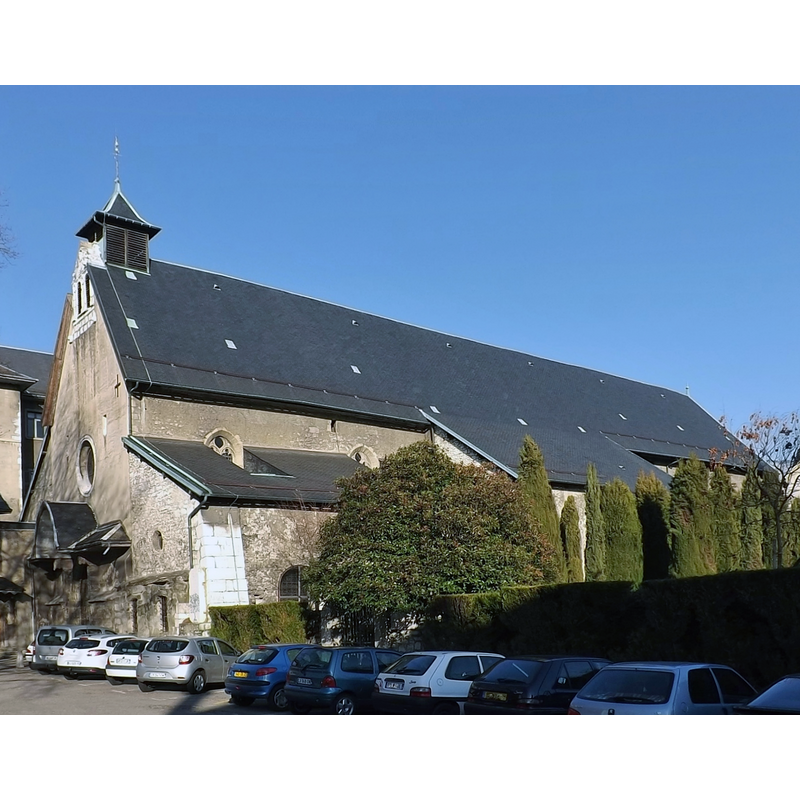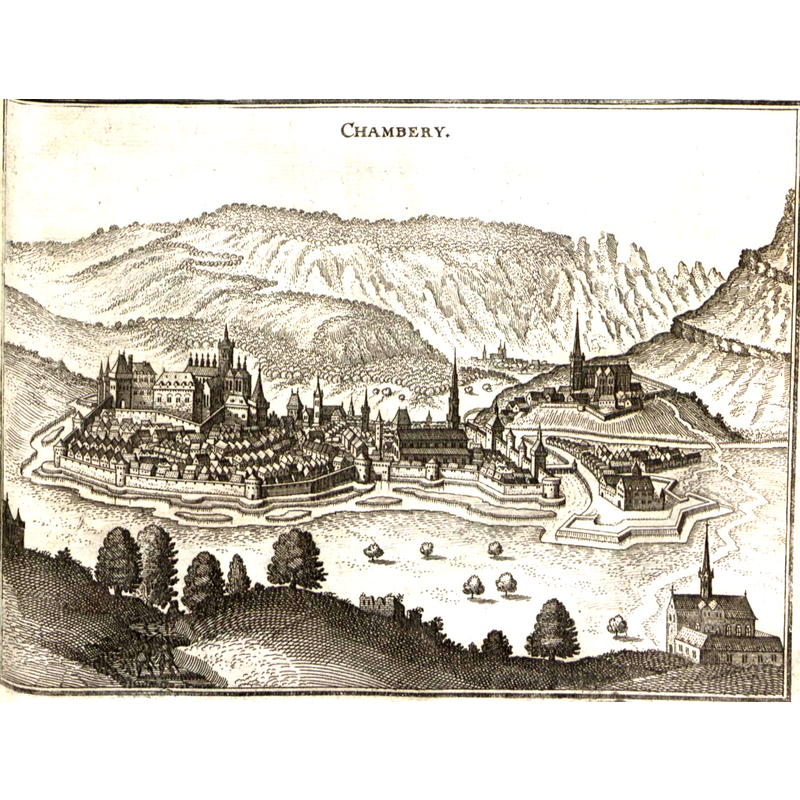Lemenc No. 1 / Lémenc in Chambéry / Lemencum

Image copyright © Florian Pépellin, 2014
CC-BY-SA-3.0
Results: 6 records
view of church exterior - southwest view
Scene Description: Source caption: " Vue de l'église Saint-Pierre-de-Lemenc, à Chambéry, en Savoie."
Copyright Statement: Image copyright © Florian Pépellin, 2014
Image Source: digital photograph 10 January 2014 by Florian Pépellin [https://commons.wikimedia.org/wiki/File:Église_Saint-Pierre_de_Lemenc_(Chambéry).JPG] [accessed 29 August 2023]
Copyright Instructions: CC-BY-SA-3.0
view of church exterior in context
Scene Description: Source caption: "Topographia Palatinatus Rheni et Vicinarum Regionum Das ist, Beschreibung vnd Eigentliche Abbildung der Vornemsten Statte, Plätz der Vntern Pfaltz am Rhein Vnd Benachbarten Landschafften, als der Bistümer Wormbs Vnd SpeÈyer, der Bergstraß, des Wessterreichs, Hundsrücks, ZweÈybrüggen, etc" -- "Vue de l’église, à droite sur les premiers contreforts de Lémenc, en 1645."
Copyright Statement: Image copyright © [in the public domain]
Image Source: digital image 16 December 2010 of an illustration by Matthäus Merian in Martin Zeiller's Topographia Germaniae (1645, vol. 5) [https://commons.wikimedia.org/wiki/File:Chambery_1645.jpg] [accessed 29 August 2023]
Copyright Instructions: PD
view of church interior - crypt - detail
Scene Description: Source caption: "La crypte de Lémenc, église Saint-Pierre de Lémenc, Chambéry."
Copyright Statement: Image copyright © [in the public domain]
Image Source: digital photograph 23 March 2003 by francois73 [https://commons.wikimedia.org/wiki/File:Cryptelemenc2.JPG] [accessed 29 August 2023]
Copyright Instructions: PD-self
view of church interior - crypt - detail
view of church interior - crypt - detail
Scene Description: arguable whether this is a baptistery or not [cf. FontNotes]
Copyright Statement: Image copyright © Petit Patrimoine, 2023
Image Source: digital photograph in Petit-patrimoine [https://www.petit-patrimoine.com/fiche-petit-patrimoine.php?id_pp=73065_4] [accessed 29 August 2023]
Copyright Instructions: PERMISSION NOT AVAILABLE – IMAGE NOT FOR PUBLIC USE
view of church interior - crypt - detail
Scene Description: arguable whether this is a baptistery or not [cf. FontNotes]
Copyright Statement: Image copyright © Petit Patrimoine, 2023
Image Source: digital photograph in Petit-patrimoine [https://www.petit-patrimoine.com/fiche-petit-patrimoine.php?id_pp=73065_4] [accessed 29 August 2023]
Copyright Instructions: PERMISSION NOT AVAILABLE – IMAGE NOT FOR PUBLIC USE
INFORMATION
FontID: 03614LEM
Object Type: Baptistery?
Church/Chapel: Saint-Pierre-de-Lémenc
Church Patron Saints: St. Peter
Church Location: 3bis Rue Burdin, 73000 Chambéry, France
Country Name: France
Location: Savoie, Auvergne-Rhône-Alpes
Directions to Site: Located off (S) the N201, 90-100 km ESE of Lyon -- Lémenc is given as a "faubourg" of Chambéry, the former capital of the Duchy of Savoie
Ecclesiastic Region: Diocèse de Chambéry, Maurienne et Tarentaise
Historical Region: Rhône-Alpes / Duchy of Savoie
Font Location in Church: In the crypt
Century and Period: 6th - 8th century, Early Christian
Credit and Acknowledgements: We are grateful to Pol Herman for his help documenting this object
Church Notes: said to have been built on a temple dedicated to Mercure -- the present chiefly 15th-16thC church is listed in Mérimée [ref.: PA00118230]
Font Notes:
Click to view
Corblet (1881-1882) reports that the ruins of a monument in Lemenc, a "faubourg" of Chambéry, were the object of some lively discussions which appeared in tome IX of the Mémoires de l'Académie de Savoie. One opinion, that of the marquis d'Oncieu, stated that it was a Romanesque crypt with its martyrium; others saw it as an ancient altar with its ciborium; doctor Cattois identified it as a baptistery of the 8th century, built under Pepin, in the occasion of the Sarracen invasion of the Graisivaudan in the 740s. However, adds Corblet, all doubts regarding the primitive function of this building should have been dissipated with the discovery by M[onsieur]. de Saint-Andéol, in 1865, of a hexagonal "piscine" [cf. Lemenc No. 2 entry in BSI] there. The Phaidon guide to France (1985) mentions a pre-Romanesque rotunda in the crypt of St-Pierre de Lémenc. The Dictionnaire des églises... (1966-) illustrates this controversial construction as "énigmatique monument, fait de six colonnes monolithes aux fûts galbés à l'antique. Coiffées d'une coupole, formant ciborium, ces colonnes montées sur des socles toriques ou polygonaux reposent sur les angles d'une basse margelle hexagonale, qui entoure une cuve peu profonde", and goes on to state that the purpose of this mysterious rotunda poses serious problems to archaeologists. Recent researches, including Valérie Delesalle-Huvé's La crypte de l’église Saint-Pierre de Lémenc : étude historique et documentaire. Art et histoire de l’art. 2018. ffdumas-02134550ff [https://dumas.ccsd.cnrs.fr/dumas-02134550] [accessed 29 August 2023] argue about the difficulties in accepting this as a baptistery and font: "il ne s’agit pas d’un baptistère, mais plutôt d’un martyrium ou d’un ciborium. Les modestes dimensions de l’édifice excluent l’hypothèse d’un baptistère. En effet, la cérémonie du baptême n’ayant lieu que quelques jours dans l’année, elle attirait une foule importante qui n’aurait pu trouver sa place dans cet édifice. Nous pouvons également signaler que la disposition de l’édicule central, avec ses colonnes très resserrées, n’est pas non plus propice à une telle cérémonie. C. d’Oncieu signale également l’absence de conduites d’arrivée et de départ pour l’eau et la nécessité, pour une piscine baptismale d’avoir une certaine profondeur. Pour beaucoup d’archéologues, la clé pendante de la voûte de l’édicule central servait à soutenir une lampe, et cela plaiderait donc en faveur d’un martyrium. Cette idée est reprise par Edmond Brocard107qui voit dans la rotonde de Lémenc une memoria. Son hypothèse se base tout d’abord sur la découverte en 1972 de l’oculus sculpté. Pour cet auteur, il s’agit d’une fenestella confessionis qui permettait aux fidèles de se recueillir devant les reliques d’un saint déposées au centre de l’édicule [...] Quoi qu’il en soit, le doute subsiste encore à l’heure actuelle sur la destination initiale de la rotonde ; en effet, même si la fonction baptismale semble devoir être écartée, il est toutefois fait mention « d’église baptismale » à plusieurs reprises [...]. L’hypothèse d’un baptistère ne peut cependant être retenue que si l’on considère qu’au départ, la rotonde était un bâtiment isolé. En effet, un baptistère situé dans la crypte d’une église obligerait les catéchumènes à traverser tout l’édifice avant de recevoir le sacrement du baptême, ce qui semble difficilement envisageable."
COORDINATES
Church Latitude & Longitude Decimal: 45.572219, 5.924031
Church Latitude & Longitude DMS: 45° 34′ 19.99″ N, 5° 55′ 26.51″ E
UTM: 31T 728151 5050679
MEDIUM AND MEASUREMENTS
Material: stone
Font Shape: hexagonal construction with ciborium
REFERENCES
Dictionnaire des églises de France, Belgique, Luxembourg, Suisse, Paris: R. Laffont, 1966-
Corblet, Jules, Histoire dogmatique, liturgique et archéologique du sacrement de baptême, Paris: V. Palme, 1881-1882


![arguable whether this is a baptistery or not [cf. FontNotes]](/static-50478a99ec6f36a15d6234548c59f63da52304e5/others/permission_not_available.jpg)